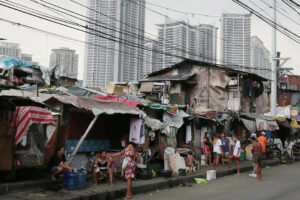High inflation puts GDP target at risk

Motorists fill up their tanks at a gas station in Novaliches, Quezon City, March 12. Fuel retailers are expected to implement another big-time hike in pump prices on Tuesday. — PHILIPPINE STAR/ MICHAEL VARCAS
By Luz Wendy T. Noble, Reporter
THE PHILIPPINES may find it more challenging to reach the government’s 7-9% economic growth target this year, as household consumption will likely take a hit from higher inflation caused by a prolonged Russia-Ukraine war, an analyst said.
The Philippine economy will probably only grow within the 5% range due to geopolitical developments that have dented recovery prospects, ING Bank N.V. Manila Senior Economist Nicholas Antonio T. Mapa said.
“Although we don’t expect growth to slow to a pace more akin to stagflation, we do know that the 7-9% growth aspiration will be a tall order,” Mr. Mapa said in an e-mail.
Finance Secretary Carlos G. Dominguez III last week said he does not expect the Russia-Ukraine crisis to “last very long,” adding the Philippine economy will only be affected because oil and food prices will continue to rise.
Prior to Russia’s invasion of Ukraine, the International Monetary Fund, World Bank and the Asian Development Bank estimated Philippine gross domestic product (GDP) will grow by 6.3%, 5.3%, and 6%, respectively, this year.
Credit raters Fitch Ratings, Moody’s Investors Service, and S&P Global Ratings projected Philippine GDP to expand by 6.9%, 7%, and 7.4%, respectively, which are near or at the low end of the government target.
Mr. Mapa said higher inflation is “all but a given which will cap consumption even during an election year.”
Household spending, which accounts for about 70% of the economy, usually gets a boost during an election year. It grew by 4.2% in 2021 following the 7.9% decline in 2020.
Crude oil prices have soared since Russia’s invasion of Ukraine.
Latest data from the Department of Energy showed the prices of gasoline, diesel, and kerosene have increased by P13.25, P17.50, and P11.40 per liter since the year started. This week, gas prices are expected to surge by P11.80-P12 per liter, diesel by P6.90-P7.20 per liter, and kerosene by P9.70-P9.80 per liter.
At the same time, the gradual relaxation of pandemic restrictions could help to boost growth but could also cause faster price increases, Asian Institute of Management economist John Paolo R. Rivera said in a Viber message.
“Our inflation figures are not yet reflecting the oil price surge but can manifest shortly when other industries and sectors feel the change in prices and when the wage spiral kicks in,” Mr. Rivera said.
Metro Manila and most parts of the country are under the most relaxed Alert Level 1. As the number of coronavirus disease 2019 (COVID-19) cases decline, there are calls to downgrade this to Alert Level 0.
Inflation stood at 3% for the second straight month in February, which is within the 2-4% target of the Bangko Sentral ng Pilipinas (BSP). However, the central bank warned that inflation could breach the target in the second quarter due to the rising oil prices, before slowing in the second half of the year.
“The worst-case scenario for inflation will not be limited to oil prices. We earlier [warned] about other transmission channels, including food and feeds, other fuel inputs for electricity, a weaker currency and other second-round impacts,” GlobalSource analyst Romeo L. Bernardo said in a note sent to BusinessWorld.
“Price pressures will likely force BSP to hike rates sooner than anticipated, and possibly even more aggressively should they delay the reversal any longer,” Mr. Mapa said.
The BSP last week said it will continue to prioritize supporting economic growth, but vowed that it will be ready in case there is need to respond to potential second-round effects from elevated inflation.
The Monetary Board’s next policy review is scheduled on March 24. It kept rates at record lows during its previous meeting on Feb. 17.
Meanwhile, the government has committed to release fuel subsidies for the transport and agriculture sector amid the surging prices. It is also reviewing petitions seeking to raise the minimum fare for public utility vehicles.
Aside from household spending, analysts also warned that government spending may drop due to the fiscal burden that increased during the pandemic.
“Public finances, already strained by pandemic assistance and stimulus programs, are coming under increasing pressure, both on the revenue and expenditure sides,” Mr. Bernardo said. He noted that policy proposals to reduce tariff and other trade barriers to mitigate inflation concerns have also hurt the government through foregone revenues.
Last year, government spending grew at a faster pace of 7.4%, from 5.1% growth in 2020.
“Government spending, a key pillar of the recovery, will possibly turn negative as the new administration faces a fiscal handicap,” ING’s Mr. Mapa said.
Outstanding debt hit a record P12.03 trillion in January as the government’s borrowings piled up due to its pandemic response. The country’s debt-to-GDP ratio was at 60.5%, the highest since the 65.7% in 2005. This is also slightly above the 60% threshold considered as manageable by multilateral lenders for developing economies.
The government has set a budget deficit ceiling of P1.65 trillion for 2022, which is equivalent to 7.7% of GDP.




